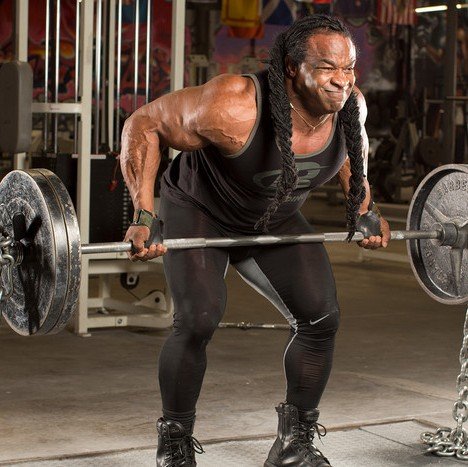There’s no denying that the classic barbell military press is one of the all-time great strength training exercises and a phenomenal mass builder for the upper body. It’s simple, it’s effective, and it doesn’t require a tremendous amount of equipment or technique. It does, however, require a bar and weights.
Along comes the handstand push-up, an equipment-free alternative that is also exceptionally effective at producing upper-body gains in both strength and mass. Sure, the two exercises can coexist in the same program, but if you’re the type who would prefer to focus on just the most effective of the two, which would it be?
Let’s compare the two exercises to see who comes out on top!
Simplicity: Handstand Push-Up Wins
It’s time to settle once and for all which is the best overhead pressing movement. Let’s break down the pros and cons of these two strength-training staples and see which prevails!
There’s no denying that the classic barbell military press is one of the all-time great strength training exercises and a phenomenal mass builder for the upper body. It’s simple, it’s effective, and it doesn’t require a tremendous amount of equipment or technique. It does, however, require a bar and weights.
Along comes the handstand push-up, an equipment-free alternative that is also exceptionally effective at producing upper-body gains in both strength and mass. Sure, the two exercises can coexist in the same program, but if you’re the type who would prefer to focus on just the most effective of the two, which would it be?
Let’s compare the two exercises to see who comes out on top!
When it comes to simplicity, I’ve always gotta side with the exercise that requires no equipment over one that is contingent upon using a specific tool. Though the press is fairly versatile, in that it can be done with dumbbells, kettlebells or other weighted objects in the absence of a bar, I love knowing that I can do handstands or handstand push-ups anywhere I go without having to find weights or a gym.
Approachability: Barbell Press Wins
The full handstand push-up can be intimidating to anyone new to strength training, and even regressed versions of the exercise like pike push-ups, where the feet remain on the ground, can still be tricky.
The barbell press, however, is a relatively basic movement pattern that most people can be taught to perform on their first day in the gym, even if it’s just with an empty bar or a broomstick. Full handstand push-ups, on the other hand, can take months or even years to achieve.
Carryover: Handstand Push-Up Wins
The first time I ever tried a handstand push-up, I was shocked by how difficult it was. At the time, I’d been doing overhead presses with weights for years and had reached a point where I could strictly press close to my full body weight overhead for reps. In spite of my perceived pressing prowess, however, I struggled to perform even a single handstand push-up. I could kick up against a wall and begin lowering myself down, but once I reached the bottom, there was no way I was going back up.
Not one to be discouraged, I began incorporating negative handstand push-ups and pike push-ups into my routine, and eventually worked my way to the full monty. While building toward that first full handstand push-up, I came to find that brute strength is not the only requirement for this unique exercise. There is also a significant amount of stability involved, as well as a very unique type of body awareness.
Handstand push-ups—the freestanding type, in particular—can also take your hand and wrist strength to the next level. Besides those extra benefits, once you get used to pressing yourself while upside down, you’ll find it gets easier to press any type of weight while standing.
Muscle Activation: Handstand Push-Up Wins
The overhead press and handstand push-up are both commonly classified as “shoulder exercises,” and while the deltoids and other shoulder muscles do play a major role in both, both are truly full-body exercises. To get the most force behind a heavy barbell press or handstand push-up, you’ll need to rely on your abs, lower back, triceps, chest, and even lats, not merely your delts. Full-body tension is useful in all forms of strength training.
The freestanding variation of the handstand push-up, however, is in a league of its own when it comes to muscle activation. When you take away the stability that resting your feet against a wall (or planting them on the ground as you would for a barbell press) provides, the proprioceptive challenges are taken to another level.
Due to the limited points of contact when performing the exercise, the amount of tension required throughout your entire upper body is unparalleled. Don’t believe me? Just kick up, and find out for yourself!
Strength Gains: Tie
There’s no denying that both of these exercises can build tremendous levels of strength. One was formerly contested as an Olympic event, after all! But this category ends up a tie, because which one you choose as the winner depends on your personal definition of strength.
If your definition of strength is the ability to press an external weight overhead, well, there’s no escaping that you’ll have to press some weights to measure yourself! However, if, like me, you define strength as the ability to navigate your own physical body through this world with power and poise, go with the handstand push-up.
Either way, I assure you that the individual in your gym who can overhead press the most weight is most likely not capable of performing several consecutive handstand push-ups. Conversely, I’m pretty good at handstand push-ups, but I’m certainly not going to be entering any weightlifting contests.
Overall Winner: Handstand Push-Up
It’s a razor-thin victory, but the handstand push-up is last man standing (upside down) on the podium. Sure, the barbell press may be more popular in your gym, but the handstand push-up isn’t just a parlor trick. It’s a strength builder of incredible power—and it can be done anywhere!
If you’re new to handstand push-ups, watch the video below for some tips and progressions to help you achieve your first rep.
Source: http://www.bodybuilding.com/





